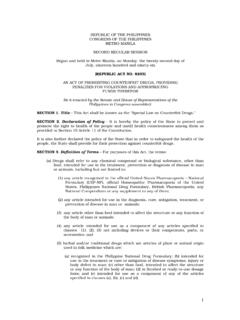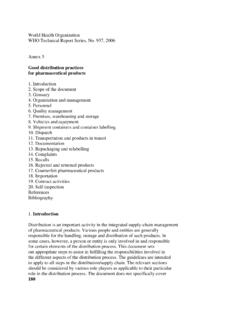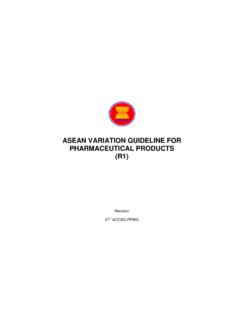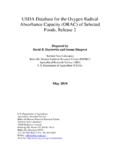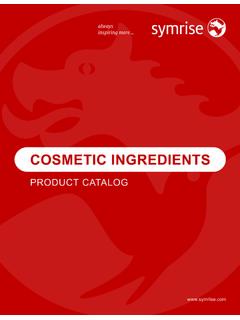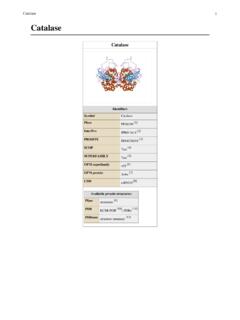Transcription of ASEAN GUIDELINE ON STABILITY STUDY OF DRUG …
1 ASEAN GUIDELINE ON STABILITY STUDY OF drug PRODUCT Update revision : 22 February 2005. 9th ACCSQ-PPWG Meeting, Philippines, 21-24 Feb 2005 LIST OF CONTENTS Page 1. INTRODUCTION 1 2. OBJECTIVES 1 3. SCOPES 1 4. DESIGN 1 General 1 Photostability Testing 2 Selection of Batches 2 Specification (Testing Parameter) 2 Testing Frequency 6 Storage Condition (General Case) 7 For NCE drug Products 9 For Generics and Variation (MaV and MiV if appropriate)
2 Products 10 drug Products Intended for Storage in a Refrigerator 10 drug Products Intended for Storage in a Freezer 11 drug Products Intended for Storage Below -20 C 11 Container Closure System 11 Evaluation 12 STABILITY Commitment 14 Statements/Labeling 15 5. ANNEXES 16 Protocol of STABILITY STUDY (example) 16 Report Format (example) 20 Reduced Design (Bracketing and Matrixing) 27 Extrapolation of Data 29 Examples of Types, Thickness and Permeability Coefficient of 30 Packaging Materials 6.
3 GLOSSARY 32 7. REFERENCES 36 1 1. INTRODUCTION The objective of a STABILITY STUDY is to determine the shelf-life, namely the time period of storage at a specified condition within which the drug product still meets its established specifications. STABILITY is an essential factor of quality, safety and efficacy of a drug product. A drug product, which is not of a sufficient STABILITY , can result in changes in physical (like hardness, dissolution rate, phase separation, etc.)
4 As well as in chemical characteristics (formation of high risk decomposition substances). Microbiological instability of a sterile drug product could also be hazardous. The STABILITY STUDY consists of a series of tests in order to obtain an assurance of STABILITY of a drug product, namely maintenance of the specifications of the drug product packed in its specified packaging material and stored in the established storage condition within the determined time period.
5 2. OBJECTIVES This GUIDELINE is intended to provide recommendations on the core STABILITY STUDY package required for drug products, but leaves sufficient flexibility to encompass the variety of different practical situations that may be encountered due to specific scientific considerations and characteristics of the products being evaluated. This GUIDELINE can also be used to propose shelf-life based on the STABILITY data generated from the STUDY package. 3. SCOPES This GUIDELINE addresses the information to be submitted in application for marketing authorization of drug products in ASEAN countries including examples of a protocol of STABILITY STUDY , a report format, reduced design and extrapolation of data, and examples of types, thickness and permeability coefficient which are covered in Annexes.
6 The drug products covered in this GUIDELINE include NCE, Generics and Variations (MaV and MiV) but exclude drug products containing vitamin and mineral preparations. 4. DESIGN General The design of the STABILITY studies for the product should be based on knowledge of the behavior and properties of the drug substance and dosage form. 2 Photostability Testing Photostability testing should be conducted on at least one primary batch of the drug product if appropriate.
7 The standard conditions for photostability testing are described in ICH Q1B. Selection of Batches At the time of submission, STABILITY data should be provided for batches of the same formulation and dosage form in the container closure system proposed for marketing. - For NCE STABILITY data should be provided on at least three primary batches of the drug products. - For Generics and Variations the following will apply : For conventional dosage forms ( , immediate release solid dosage forms, solutions) and when the drug substances are known to be stable, STABILITY data on at least two pilot scale batches are acceptable.
8 For critical dosage forms ( , prolonged release forms) or when the drug substances are known to be unstable, STABILITY data on three primary batches are to be provided. Two of the three batches should be at least of a pilot scale; the third batch may be smaller. - The manufacturing process used for primary batches should simulate that to be applied to production batches and should provide product of the same quality and meeting the same specification as that intended for marketing. - Where possible, batches of the drug product should be manufactured by using different batches of the drug substance.
9 - STABILITY studies should be performed on each individual strength and container size of the drug product unless bracketing or matrixing is applied. Other supporting data can be provided. Specification (Testing Parameter) Specification is a list of tests, reference to analytical procedures, and proposed acceptance criteria, including the concept of different acceptance criteria for release and shelf-life specifications. STABILITY studies should include testing of those attributes of the drug product that are susceptible to change during storage and are likely to influence quality, safety and/or efficacy.
10 The testing should cover, as appropriate, the physical, chemical, biological and microbiological attributes, preservative content ( antioxidant, antimicrobial preservative), and functionality tests ( , for a dose delivery system). The analytical procedure should be fully validated and STABILITY indicating according to ASEAN GUIDELINE on Analytical Validation. Whether and to what extent replication should be performed will depend on the results from validation studies. 3 The following list of parameters for each dosage form is presented as a guide for the types of tests to be included in a STABILITY STUDY .
